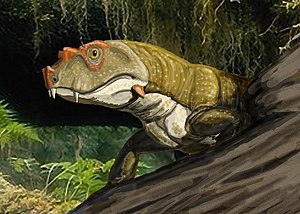Tetraceratops
| Tetraceratops | ||||||||||||
|---|---|---|---|---|---|---|---|---|---|---|---|---|

Tetraceratops |
||||||||||||
| Temporal occurrence | ||||||||||||
| Kungurium ( Unterperm ) | ||||||||||||
| 279.5 to 272.5 million years | ||||||||||||
| Locations | ||||||||||||
|
||||||||||||
| Systematics | ||||||||||||
|
||||||||||||
| Scientific name | ||||||||||||
| Tetraceratops | ||||||||||||
| Matthew , 1908 |
Tetraceratops is an extinct genus of synapsid terrestrial vertebrates and possibly the most primitive therapside (formerly known as "mammal-like reptiles"). She lived during the lower perm . The only species described is Tetraceratops insignis . The holotype , an incomplete, crushed skull,foundon the Wichita River in Baylor County (north Texas ) by the American fossil collector and hobby paleontologist Charles Hazelius Sternberg is kept in the American Museum of Natural History in New York . To this day it is the only fossil in the genus.
features
The skull is short, only four inches long and high. A pair of short, bony outgrowths are on the premaxillary above the nostrils and on the vorfontale in front of the eyes, Tetraceratops means "four-horned face ". Tetraceratops thus resembles the Burnetiidae , in which the outgrowths are, however, formed by other bones. Two further outgrowths, which were not yet known at the time of the first description, can be found on the side of the two angulars, bones that form part of the lower jaw in primitive land vertebrates and have become ossicles in mammals . The dental is the largest single bone in the lower jaw. The tear bone (lacrimale) forms the front part of the eye socket (orbit).
The teeth indicate Tetraceratops as a carnivore. The first two incisors on the premaxillary are much larger than the four following. There is a toothless gap ( diastema ) between the teeth on the premaxillary and those on the maxillary . There are large canines on the maxillary, the teeth behind them have sharp, curved crowns. There are six large teeth on a posterior outgrowth of the wing bone (pterygoid), part of the palate. The teeth end in front of the outer wing bone (ectopterygoid).
Systematics
Tetraceratops was described in 1908 by William Diller Matthew as a new pelycosaur , which is closely related to the Sphenacodontidae . Alfred Romer and Llewellyn Price assigned the genus in 1940 to the Eothyrididae , another, little-known pelycosaur family. In 1996, Michel Laurin and Robert Reisz added Tetraceratops to the Therapsids because of some skull features . If this assessment is correct, Tetraceratops is to be regarded as the oldest and most original Therapside. Phylogenetically, it could represent the sister genus of all other therapsids. There is a gap of 10 million years between Tetraceratops and the first safe therapsids found in fossil records in Russia and South Africa. In 2001, J. Conrad and C. Sidor again found indications that it should be classified as Sphenacodontidae. Some diagnostic features of therapsids can not be verified in Tetraceratops because the skull is too incomplete. Tetraceratops can be classified as a mosaic form between pelycosaurs and therapsids.
literature
- M. Laurin, RR Reisz: The osteology and relationships of Tetraceratops insignis, the oldest known therapsid. In: Journal of Vertebrate Paleontology. 16, 1996, pp. 95-102. Abstract at JSTOR.org
- Thomas Stainforth Kemp: The origin and evolution of mammals. Oxford University Press, 2004, ISBN 0-19-850761-5 , pp. 27-30.
Individual evidence
- ↑ William Diller Matthew: Triceratops insignis gen. Et sp. nov. In: Bulletin of the American Museum of Natural History. 24, 1908, pp. 183-187.
Web links
- Therapsida at Palæos
- The Paleobiology Database Tetraceratops